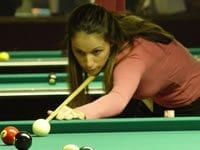Planting The Seed
APA was the beginning of my journey through the pool world. It taught me fundamentals that are relevant to my pool career now. It was my first introduction to structured and competitive pool. I instantly became addicted to the competition and began taking lessons and playing on several APA teams (sometimes 3 or 4 nights per week) for several years. Throughout this time, I competed in many National APA tournaments including the Jack & Jill Championship, Triple Play Masters, 8-Ball Team and U.S. Amateur Championships. All of my experiences in the APA helped prepare me for later competitions. After 5 years of playing competitively, I eventually earned a qualifier spot in my first WPBA event in 2008 and earned my exempt status at the end of 2009.
Through the APA I met many incredible people, including several women that have also earned their WPBA exempt status or regularly play in WPBA events. In the years that I qualified for the U.S. Amateur Championship in Atlanta, I became friends with Michell Monk from Florida, who later won the U.S. Amateur Championship and is now a WPBA exempt player. Although we’ve had to compete against each other on the table, we are friends off the table. Michell often volunteers to help me with rides from the airport or a place to stay when I come to tournaments in her area. Recently, Michell and I signed on as part of Team Gambler and will join another fellow APA player, Betty Sessions, to represent the pool and poker clothing company, Gambler Clothing. Other former APA players who are also now exempt players on the WPBA Classic Tour are Amy Chen and Denise Belanger, just to name a few.

Yu Ram Cha, Samm Diep and Cristina at the finals of the Predator World 10-Ball Invitational where Cristina and Samm worked for InsidePOOL Magazine.
Another close friend I met along the way is Samm Diep, a writer, reporter and instructor from Denver. Samm introduced me to a side of the game that I enjoy even more than playing. Samm worked with InsidePOOL Magazine as a writer and reporter. After hearing about my experience with training high school debate teams, she arranged an audition for me. From this audition, I began doing video podcast interviews and writing articles for InsidePOOL Magazine, which grew to commentating and presenting for many other promoters and publications at other men’s and open professional events. Throughout my work over the past few years I have been lucky enough to interview and commentate on matches of many of the world’s top players, including pool legends like Efren Reyes, Allison Fisher and Mika Immonen. However, I was most nervous the first time I interviewed Jeanette Lee. I knew she was a very approachable, charismatic person, so it would be easy to interview her, but I also knew she does presenting for a living and I was completely self conscious about EVERYTHING I did. And to top off my nervousness, a friend had warned me that Jeanette might critique me and offer some helpful advice after our interview. Jeanette was a true professional and tried to help put me at ease before the interview, but as you can see in this video, my nervousness still showed through: http://www.youtube.com/watch?v=hi1QiIIuAk4
Video interviews from my most recent trip to Spain can be found at www.Predator10Ball.com.
My Introduction to APA
I am a very competitive person by nature. Because of that, I don’t like to play sports that I am not good at or at least have some potential to be good at. However, when I first started playing pool, I was definitely below average, and like many beginning players, I had no idea how much I didn’t know about the game.
I was out with some friends one night when a mutual friend asked me to join their APA team. I enjoyed playing pool for fun while killing time between classes in college, so I thought it would be a fun thing to do since I just moved back to town. At the time, I never could have imagined where this game would take me and the incredible places I would see.
While playing in a local weekly tournament I happened to meet a local instructor and began taking lessons with him. Not knowing what to expect in our first lesson I went in very open-minded.
Before we even picked up a cue he said we needed to talk and simply said, “What are your goals in pool?” It sounds like a fairly simple question at face value, but in trying to answer, I realized that I had never really thought about it. Did I want to improve so I can win more APA matches? Did I want to someday play at pro level? Did I just want to understand the game better to enjoy playing more? After thinking for a minute I realized that I don’t do anything half way.Either I put everything into it or I don’t, so I told him that I want to be a professional player some day.
The next thing he told me was probably one of the most valuable things I ever learned in pool, “At the level you want to be playing, everyone can run out an open table. The player that controls the table the best when it’s not an open layout is the one that will win matches.”
Pro Players Play Safeties, Too
When we think about pro players, we often think about break and runs and how consistent their shot making abilities are. We don’t often think about their incredible safety abilities. But, the concept is genius! I don’t have to be able to run nine balls if I can play good safeties. I only have to be able to run a few balls at a time, play a good safety shot, and then run a few more balls. With this in mind, my instructor taught me a handful of routine safeties that come up regularly before he ever taught me patterns.
The first thing to learn about playing safety shots is to judge when to use them. Sometimes you play a safety shot when there are no offensive choices. Other times you do have an offensive shot, but maybe it’s a difficult shot that you have a low percentage of making and successfully getting shape on your next ball. In both of those scenarios, it’s fairly easy to decide on playing safe.
There are instances, though, where playing a safety shot is not so obvious. Sometimes, in 8-Ball for instance, you have several open shots, but one or two balls that are tied up. This is a good time to consider playing safe. Remember, a safety or defensive shot can also be a shot where you simply are not attempting to pocket a ball. You don’t necessarily have to be trying to “hook” your opponent, but rather just create a more favorable layout for yourself. Even though you may have available offensive shots, it’s not always to your advantage to run out those open balls, particularly if you run down to the point where all you have left are the one or two balls that are tied up. If your remaining balls are tied up and your opponent has open balls, there is a high percentage chance that your opponent will win that game. So rather than get down to that point, you can play a safety earlier in the rack to make the layout better for yourself later in the game. In this type of situation you can do a number of things. You can move one of your balls to a position that blocks one or more of your opponent’s shots. You can move one of your balls closer to your tied up balls so you can later use that ball to break out the tied up balls. Pool is much like a chess game, you want to be the one that makes the last move—almost winning doesn’t count.
The next thing to learn about safeties is how to ensure you get the most out of the shot. This concept is most effective in 9-Ball because you are usually trying to hide the object ball from your opponent. When first beginning to play safeties, many players try to do too much with the shot. It’s very difficult to control two balls at once, so start out by just trying to control one: the cue ball OR the object ball. We aren’t perfect and the balls aren’t always going to do what we want them to do, so keep it simple. Think about how you WANT the balls to end up and then decide which one is more important. If you get the cue ball where you want it to go, but not the object ball, will it still be an okay safety? Or is it better if you get the object ball where you want it, but not the cue ball? Obviously you want to try to get the balls exactly where you want them; decide which one is most important before trying to execute the shot.
Safeties are a very important part of the game and that doesn’t change when you begin to play at higher levels. The safeties just get more precise and deadly. I’m still not at the point where my shot making ability can keep up with the top WPBA pros, so I have to rely on my safeties and kicking. But I know that if I stick to my game plan and just control the table, I’m much more likely to get more chances at the table and that greatly increases my chances of winning.


